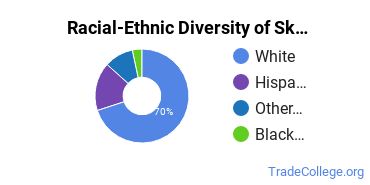Skinworks School of Advanced Skincare Trade Programs
Skinworks School of Advanced Skincare is a private for-profit institution situated in Salt Lake City, Utah. The suburban atmosphere of Salt Lake City makes it a great place for students who want the amenities of city life without actually living in the middle of a constant hustle and bustle.
Featured schools near , edit
Where Is Skinworks School of Advanced Skincare?

Contact details for Skinworks School & Spa of Advanced Skincare are given below.
| Contact Details | |
|---|---|
| Address: | 2121 South 230 East, Salt Lake City, UT 84115 |
| Phone: | 801-530-0001 |
| Website: | www.skinworks.edu |
Can I Afford Skinworks School & Spa of Advanced Skincare?
Student Loan Debt
It's not uncommon for college students to take out loans to pay for school. In fact, almost 66% of students nationwide depend at least partially on loans. At Skinworks School & Spa of Advanced Skincare, approximately 60% of students took out student loans averaging $7,010 a year. That adds up to $28,040 over four years for those students.
Skinworks School of Advanced Skincare Undergraduate Student Diversity
Racial-Ethnic Diversity
The racial-ethnic breakdown of Skinworks School of Advanced Skincare students is as follows.

| Race/Ethnicity | Number of Grads |
|---|---|
| Asian | 8 |
| Black or African American | 2 |
| Hispanic or Latino | 37 |
| White | 82 |
| International Students | 0 |
| Other Races/Ethnicities | 15 |
Skinworks School of Advanced Skincare Trade School Concentrations
The table below shows the number of awards for each concentration.
| Major | Basic Certificate | Undergraduate Certificate | TOTAL |
|---|---|---|---|
| Master Aesthetician/Esthetician | 2 | 57 | 59 |
| Aesthetician/Esthetician & Skin Care Specialist | 38 | 0 | 38 |
| TOTAL | 40 | 57 | 97 |
References
*The racial-ethnic minorities count is calculated by taking the total number of students and subtracting white students, international students, and students whose race/ethnicity was unknown. This number is then divided by the total number of students at the school to obtain the racial-ethnic minorities percentage.
More about our data sources and methodologies.
Featured Schools
 Request Info
Request Info
|
Southern New Hampshire University You have goals. Southern New Hampshire University can help you get there. Whether you need a bachelor's degree to get into a career or want a master's degree to move up in your current career, SNHU has an online program for you. Find your degree from over 200 online programs. Learn More > |
